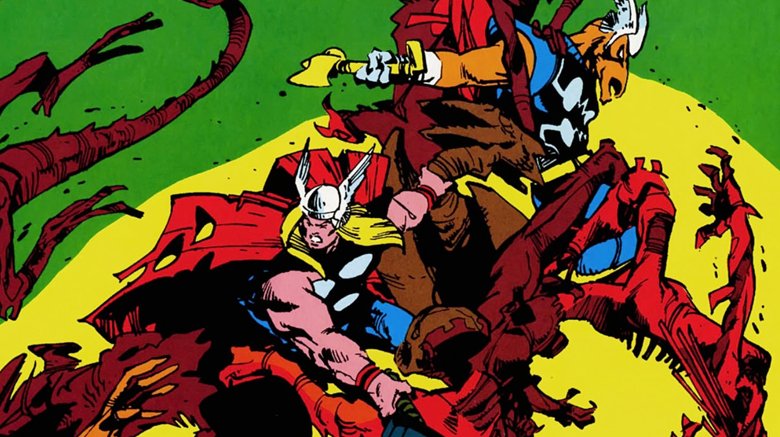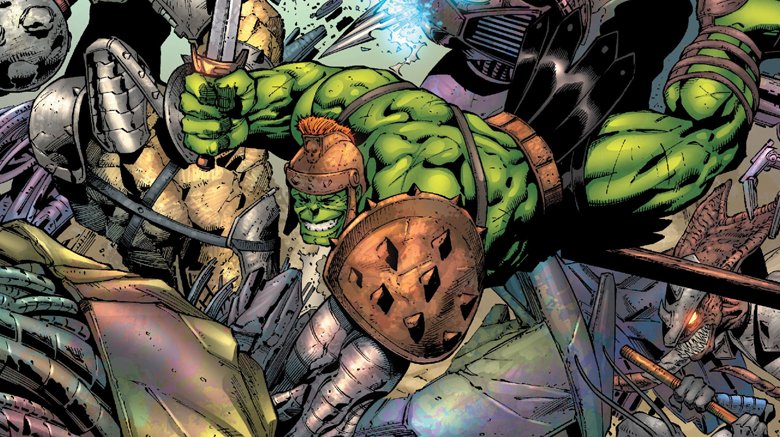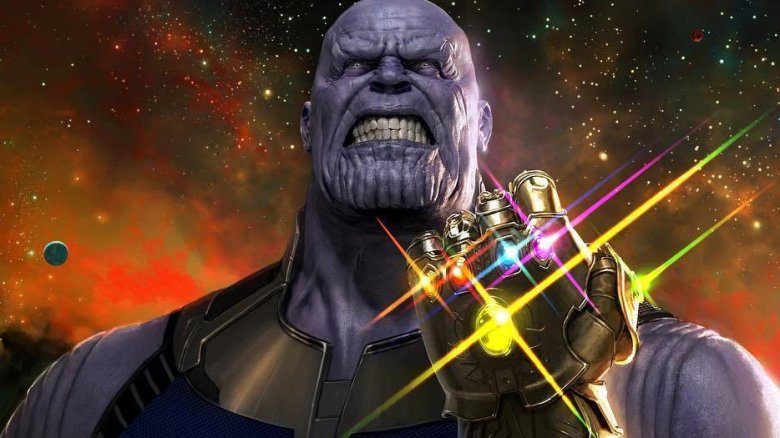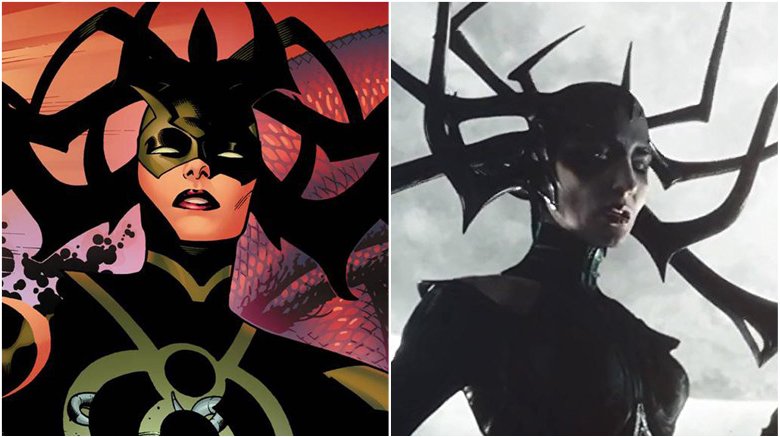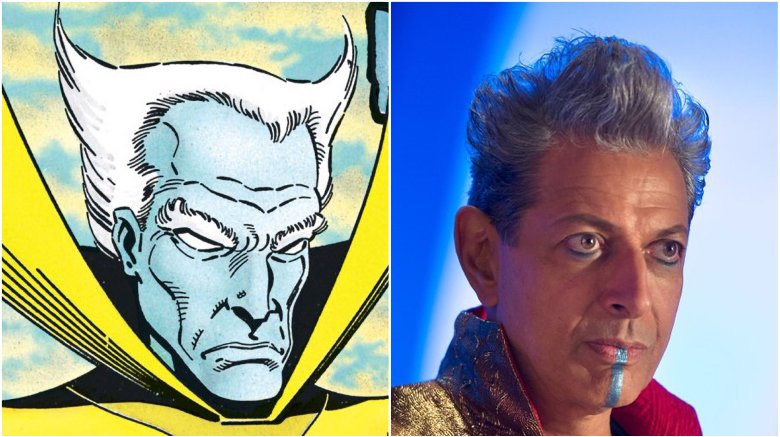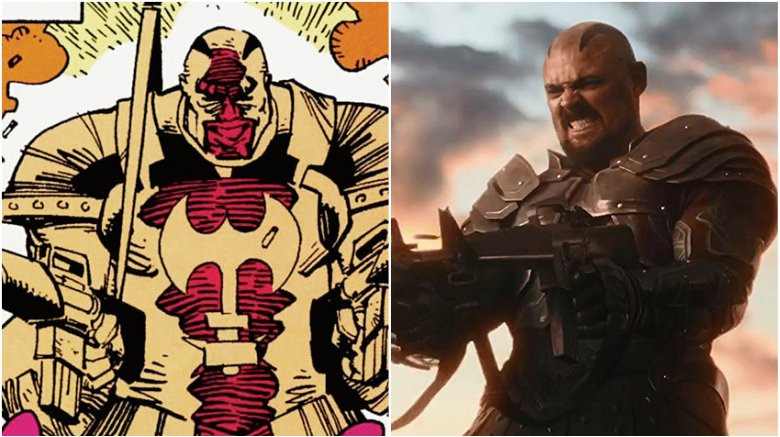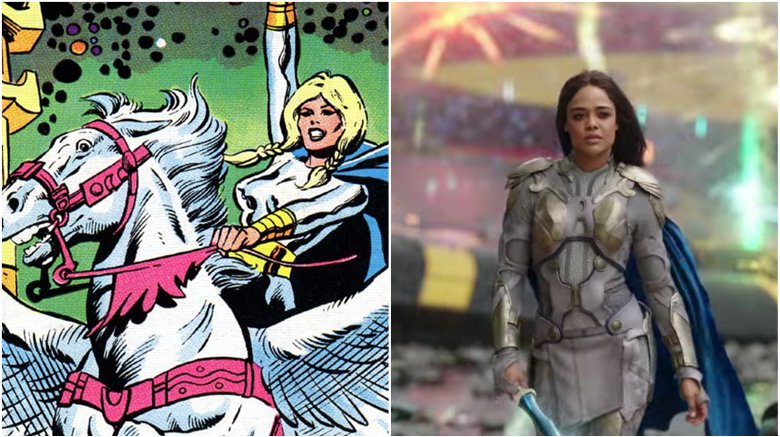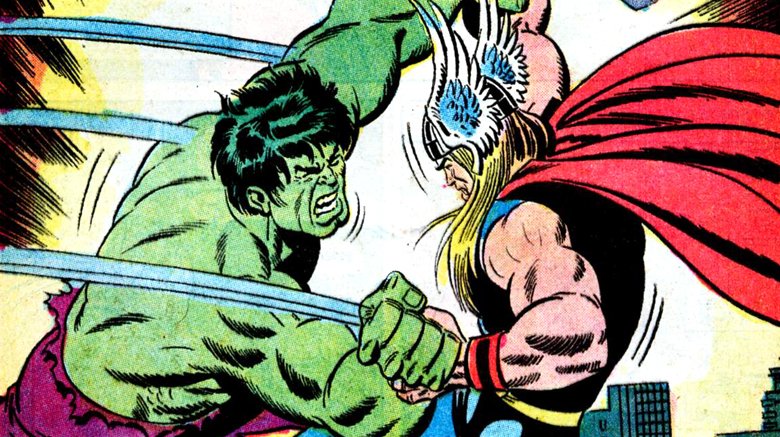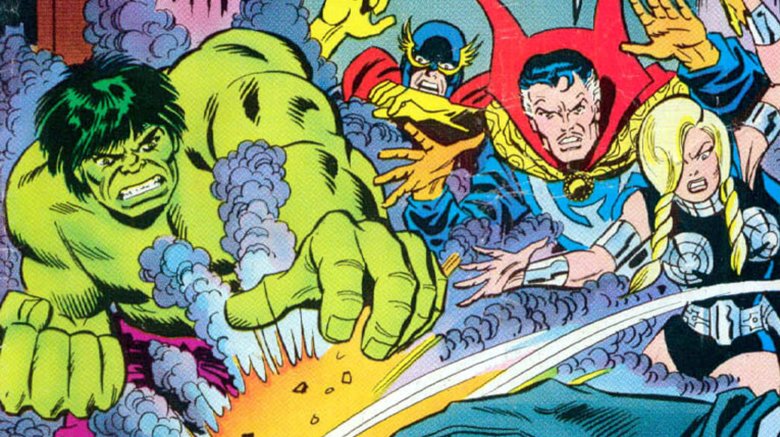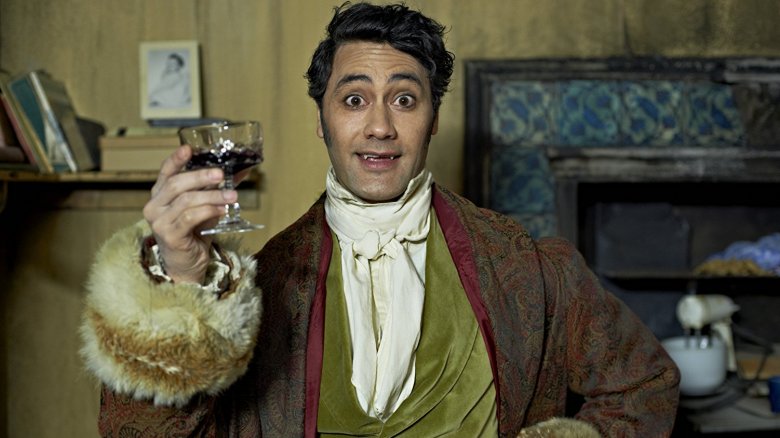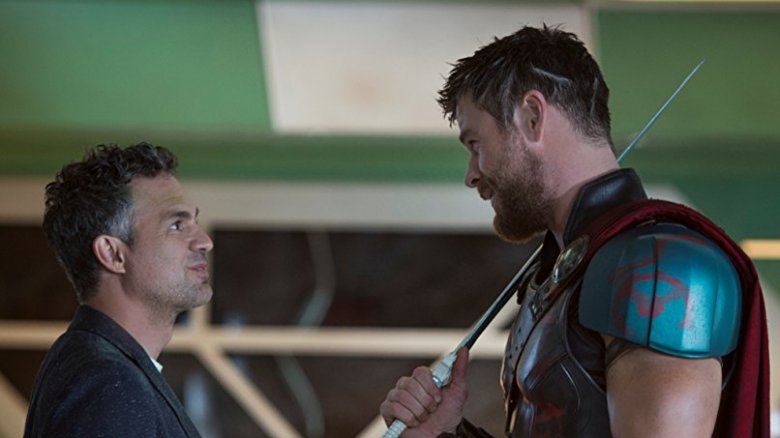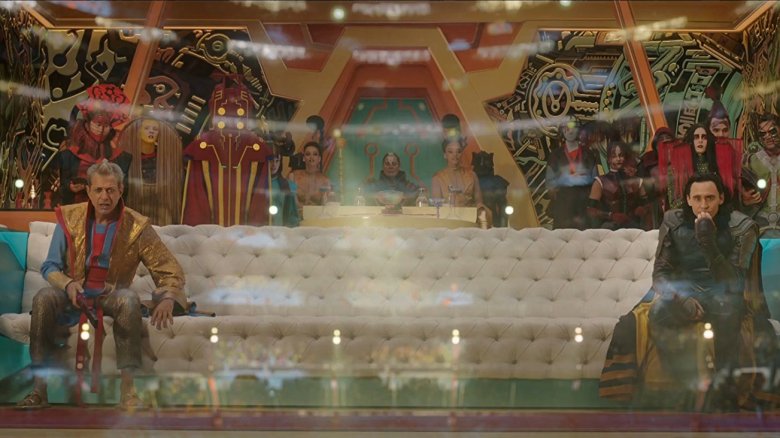The Untold Truth Of Thor: Ragnarok
Thor: Ragnarok is the 17th movie in the Marvel Cinematic Universe, and it's been clear since the release of the first trailer that it's unlike any of its predecessors in the MCU. Directed by Taika Waititi from a screenplay by Eric Pearson, Craig Kyle, and Christopher Yost, Thor: Ragnarok is a whirlwind of color, unique design, and over-the-top heroic moments whose sci-fi premise and comedic tone shares more with the Guardians of the Galaxy films than previous Thor or Avengers entries—and Waititi's style is just as different from James Gunn's as it is from Joss Whedon's.
To map out what makes Thor: Ragnarok so unique, we have to go all the way back to its story's origins, starting with the influential comics creator who was working on the Thor comics more than 30 years ago.
Walt Simonson's Thor
Walt Simonson was the writer on Thor from #337 to #382, and also drew most issues from #337 to #367. His tenure is widely regarded as one of the best runs by a single creator on any comic in the history of the medium. Simonson has always been inspired—even more than most comics artists—by the work of Thor co-creator Jack Kirby, and his Thor stories gave him the opportunity to take Kirby's big, colorful concepts to another level. His Thor is known for its bombastic action and epic plotting, combined with an intelligent approach to character development. He introduced the fan favorite character Beta Ray Bill, a monstrous but heroic alien with the same powers as Thor and a sci-fi version of his costume. He also did an amazing job of developing existing characters like Balder, Sif, and the Warriors Three, as well as Thor and Loki themselves.
Two villains Simonson created, Malekith and Kurse, were very loosely adapted for Thor: The Dark World, but Thor: Ragnarok is the first movie to show an interest in the kind of stories Simonson actually told, and the aesthetics he employed to tell them. Not only was Simonson the creator who fully integrated science fiction into Thor, he was also the first to bring about Ragnarok, the mythical apocalypse of the Norse gods, in Marvel's Thor comics. Kirby and others had toyed with the elements of Ragnarok, but under Simonson it finally happened: the fall of Asgard and the last stand of its heroes. Furthermore, a key element of Simonson's Thor was the wrath of the goddess of death Hela, who appears as the main villain in Thor: Ragnarok.
Add Planet Hulk
Simonson inspired Thor: Ragnarok, but he isn't responsible for all of its ingredients. The other key element that's been blended with his work is the Planet Hulk storyline by Greg Pak, Carlo Pagulayan, and Aaron Lopresti, which ran in Incredible Hulk #92-105 in 2006 and 2007. Planet Hulk introduces the planet Sakaar, a kind of interstellar dumping ground where beings and technology from across the cosmos end up after falling into conveniently placed wormholes. The hostility of the local culture turns out to be an environment where the exiled Hulk can thrive, and he becomes a popular star of their fighting pits. In Planet Hulk, he goes on to lead a revolution and become the ruler of Sakaar, but in Thor: Ragnarok, he leaves with Thor to help save Asgard.
Connect it to the larger MCU
We don't yet know exactly what Avengers: Infinity War will bring, but we know Thor: Ragnarok plays a role in setting it up. This is why the Grandmaster is in charge on Sakaar, rather than the Red King from the Planet Hulk comics. Ragnarok also features Doctor Strange, who first met Thor in the credits sequence of his own movie. Positioning him as Thor and Hulk's ally in this film enables them to bring him into the fold of the Avengers in time for the battle against Thanos in Infinity War.
The same thing will likely happen with Valkyrie, who appears in Ragnarok. And just putting all of these characters in outer space, outside the realms of Earth and Asgard, can easily lead directly to the involvement of the Guardians of the Galaxy. Basically, while Thor: Ragnarok has its own free-standing story to tell, each element also serves to set up future stories.
Who is Hela?
Hela is based on Hel, the mythological Norse death goddess, but she was created by Stan Lee and Jack Kirby in 1964 during their original Thor run. She rules over the grim afterlife realms of Hel and Niflheim, where the dishonored, evil, and cowardly go when they die. She frequently tries to expand her rule to encompass worlds like Asgard and even Earth. In both mythology and the comics, she has a role to play in Ragnarok, when the dead invade the realms of the living. Her involvement in Thor: Ragnarok raises the stakes, both because she's an avatar of Ragnarok itself and simply because she's an embodiment of death.
Furthermore, casting veteran actress Cate Blanchett in the role marks Hela as someone extremely powerful and not to be messed with. After all, one of Blanchett's most memorable roles (certainly the one she's played in the largest number of movies) is Galadriel, the immensely powerful and ancient elf in Peter Jackson's Lord of the Rings and The Hobbit movies. She's also known for playing Queen Elizabeth I in Elizabeth (the film that made her a star) and its sequel Elizabeth: The Golden Age. Basically, Blanchett knows her way around powerful and regal characters, and as Hela she takes that in a much darker direction as the nigh-unstoppable Queen of the Underworld.
Who is the Grandmaster?
The Grandmaster was created by Roy Thomas and Sal Buscema, and first appeared in The Avengers Vol. 1 #69. He's one of the Elders of the Universe, a group of unfathomably ancient beings that also includes the Collector (portrayed in the MCU by Benicio del Toro). Each of the Elders has a specialty/obsession, and as his name implies, for the Grandmaster it's games. He loves both strategic displays of skill and games of chance, and the scale of his wagers and competitions often puts entire planets at risk.
In the comics, the Grandmaster originally held the Infinity Gem of the Mind before Thanos took it to assemble the Infinity Gauntlet. In the movies, that stone has already been found inside Loki's staff and given to the Vision. The Grandmaster, played by Jeff Goldblum, reigns over the arena battles on Sakaar, but being an Elder of the Universe, he obviously has other things going on—which makes Goldblum, who's known for playing intelligent and sarcastic characters in movies like Jurassic Park and Independence Day, an intriguing choice.
One significant divergence from the comics is the skin color of Goldblum's Grandmaster—unlike his counterpart on the printed page, the MCU version of the character doesn't have blue skin. According to director Taika Waititi, they decided not to make Goldblum blue because they didn't want to remind people of his role in the 1989 cult comedy Earth Girls Are Easy.
Who is the Executioner?
Skurge, also known as the Executioner, is a supervillain dating back to 1964, when he was created by Lee and Kirby. He debuted in Journey Into Mystery #103, alongside his longtime partner Amora the Enchantress. The duo started as Thor villains specifically, but became best known as enemies of the Avengers and early members of the Masters of Evil. During Walt Simonson's time on Thor, Skurge came to terms with the fact that his beloved Amora never truly loved him back and joined Thor's battle against Hela and the forces of the dead, ultimately giving his life holding back Hela's army at the bridge Gjallerbru.
In Thor: Ragnarok, Skurge is played by Karl Urban, a genre veteran who played Eomer in Lord of the Rings and Dr. "Bones" McCoy in the rebooted Star Trek films. Just comparing those two roles makes it obvious that Urban is a bit of a chameleon, and he's once again transformed himself for Ragnarok, in which he looks basically identical to the comic book version of the Executioner. But what's been really exciting for fans of Simonson's work is the shot in the trailer of Skurge double-fisting machine guns, which is immediately recognizable as Skurge's last stand at Gjallerbru. The prospect of one of the most celebrated comics scenes making it to the screen immediately ramped up anticipation among longtime readers.
Who is Valkyrie?
Valkyrie is a Marvel superhero with a complex and sometimes confusing history, most of which takes place outside of Thor's comics, despite her mythological connection to his world. Her original incarnation, introduced by Roy Thomas and John Buscema in The Avengers Vol. 1 #83, was presented as a false identity created by Amora the Enchantress, and was basically a parody of the feminist movement. Steve Englehart and Sal Buscema brought Valkyrie back in The Defenders #4, revealing her to be a separate being from Amora; subsequently, Valkyrie became a more fleshed-out character, and a long-running member of the Defenders. It turned out that before she'd become Amora's puppet, she was Brunnhilde, a literal Valkyrie of Asgard, one of the warrior women who escort the valiant dead to Valhalla on behalf of Odin.
Tessa Thompson plays Valkyrie in Thor: Ragnarok. Despite being a black woman and not wearing her hair in the traditional Norse braids, Thompson is recognizably the same character from the Marvel comics. Valkyrie has always been defined by her iron will and hunger for action, both of which the movie version has in spades. That makes Thompson, of Creed and Westworld fame, a perfect choice for the role. She's less recognizable in the reddish brown outfit she wears on Sakaar, but the gold and silver armor with the blue cape that she wears in the Asgard scene is extremely similar to a costume Valkyrie wore in the pages of The Defenders.
Hulk and Thor: Friends from work
The Hulk and Thor have been associates (friends from work, if you will) for a very long time. They first met in The Avengers Vol. 1 #1, in which they were co-founders of the team alongside Iron Man, Ant-Man, and the Wasp. They first appeared on screen together in the 1988 TV movie The Incredible Hulk Returns, a continuation of the Incredible Hulk TV show that was created with the idea of spinning off a show about Thor, but that idea never got off the ground. IChris Hemsworth and Mark Ruffalo brought the characters together again for 2012's The Avengers, starting them on a path that leads directly to Thor: Ragnarok.
In the comics, Thor and the Hulk have teamed up and fought each other many times over the decades. Ultimately, however, they're allies, united not just by being two of the physically strongest heroes in the Marvel Universe, but by the relative simplicity of their world views, and their shared love of smashing those who deserve it, whether with a hammer or big green fists.
In the Thor: Ragnarok trailer, the moment that got the most laughs and set the tone for the entire film is Thor's line upon facing the Hulk in the Grandmaster's arena: "We know each other! He's a friend from work!" According to Hemsworth, that line wasn't in the script—or ad-libbed by him. Instead, it was suggested by a young boy who was visiting the set thanks to the Make-A-Wish Foundation, the organization that provides memorable experiences to seriously ill children. It went over so well that it ended up in the movie, much to the eventual delight of millions.
The Defenders connection
Hulk's closest closest comics relationships with other heroes in Thor: Ragnarok, however, are with Doctor Strange and Valkyrie. The Hulk and Strange were co-founders of the Defenders alongside Namor the Sub-Mariner and the Silver Surfer, and as mentioned above, Valkyrie joined that team early on. In the Bronze Age of Comics (roughly 1970-1985), when the Hulk was an outcast from the Avengers and had an adversarial relationship with most superheroes, Valkyrie and Doctor Strange were two of his closest allies. Even if none of that is directly relevant in the MCU, it resonates with fans of those comics just to see the three together.
And although he was always an Avenger and never a Defender in the comics, in the MCU Thor has important connections with all three heroes. As discussed above, he and the Hulk are united by strength and attitude (and having been Avengers together). Thor and Doctor Strange are the two most prominent magic-based heroes in the MCU. And of course Thor and Valkyrie are two of Asgard's greatest warriors.
A unique director
If Thor: Ragnarok seems radically different from any Marvel movie that's come before, the differences can be summed up in two words: Taika Waititi. An actor/director from New Zealand, Waititi cut his teeth directing episodes of the HBO series Flight of the Conchords and the New Zealand TV show Super City. He made a huge splash in 2014 with the vampire mockumentary What We Do in the Shadows, and had another critical success with his follow-up film Hunt for the Wilderpeople. Waititi tells stories in a unique, off-kilter style that's extremely different from the typical American blockbuster, which is what makes him such an interesting choice to direct one.
Taika Waititi is also Māori of the Te Whānau-ā-Apanui iwi people, one of the indigenous groups that populate New Zealand, which gives him a different perspective from most previous MCU directors—not just on culture and storytelling in the cinematic sense, but on the kinds of inherited mythologies upon which the Thor books (and in a sense, all comics) are built. Waititi pushed for diversity both behind and in front of the camera on Ragnarok, and invited a group of the Yugambeh people of Australia to do a traditional welcoming ceremony before shooting on their land.
Being an actor as well as a director, Waititi also tends to appear in the films he makes, and Thor: Ragnarok is no exception. Waititi plays Korg, an alien rock creature who originated in Planet Hulk.
Improv the dialogue
One of the unique things Taika Waititi brings to Thor: Ragnarok is a preference for improvisation. In fact, Waititi has said that 80 percent of the dialogue in Thor: Ragnarok is improvised, which helps lend the film its loose and breezy tone, a stark contrast with both the often stiff pronouncements of previous Thor installments and the obviously scripted cleverness of Joss Whedon's Avengers dialogue. Waititi makes movies that feel like the people in them are having fun hanging out with each other, which makes the moments between Thor and Hulk feel particularly interesting, and also affects their dynamics with Valkyrie and Loki in a noticeable and entertaining way. Plus, it gives Jeff Goldblum the room to be Jeff Goldblum, which is always what you want him to do.
A movie that looks like nothing else
Waititi also brought in New Zealand-based production designer Dan Hennah, who previously worked on Peter Jackson's The Hobbit trilogy. Hennah turned back to Jack Kirby in particular for inspiration, creating a colorful blend of science fiction and mythology that looks totally unique. In fact, there are murals in the back of the box where the Grandmaster and Loki watch the arena battle that are actual Jack Kirby artwork blown up from the comics, which is a unique way of paying tribute to the artist whose work inspired all of this.
The worlds Jack Kirby created with Stan Lee inspired Walt Simonson, Roy Thomas, Steve Englehart and the Buscema brothers. Their work, in turn, inspired younger creators like Greg Pak, Carlo Pagulayan, and Aaron Lopresti, and the comics made by all those creators are then filtered and reinterpreted by the filmmakers—who helped the actors involved put their spin on their characters and situations. This vast collection of talented influences has all led to a very unique film with one Hel of a pedigree, and we can't wait to see where the MCU takes things from here.
